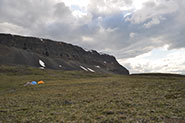The research focused on transitions from the sub-aqueous to sub-aerial depositional environment (passage zones) recording the high stands of englacial lakes, from which minimum ice thicknesses can be calculated. Such reconstructions of the Pleistocene icesheet are important to obtain a better, more complete palaeoclimate record.
The Kima’Kho volcano is a small volume volcano, which erupted through the continental ice sheet in the early Pleistocene (1.82 million years ago). It consists of an early explosive pyroclastic cone with a later effusive lava delta, the latter preserving a classical lava-delta passage zone. The researchers, Professor Kelly Russell (UBC), Professor Benjamin Edwards (Dickinson) and Dr Lucy Porritt (Bristol) documented a higher, pyroclastic passage zone than that recorded by the effusive lava delta. This implies that previous estimates of ice thickness were too low.
Prior to this research only effusive passage zones had been documented, with many entirely pyroclastic sequences overlooked for their potential palaeoclimate information. Recognising explosive (pyroclastic) passage zones in glaciovolcanic sequences may provide important information about climate and ice sheet thickness in areas where previous methods have had little success.
Dr Porritt of Bristol’s School of Earth Sciences, said: “We hope that our discovery encourages more researchers to seek out pyroclastic passage zones. With more detailed mapping of glaciovolcanic sequences, and the recognition of these often abrupt changes in depositional environment, our understanding of glaciovolcanic eruptions and the hazards they pose can only be advanced.”
Paper
'Pyroclastic passage zones in glaciovolcanic sequences' by James K. Russell, Benjamin R. Edwards and Lucy A. Porritt in Nature Communications
The Cabot Institute
The Cabot Institute at the University of Bristol carries out fundamental and responsive research on risks and uncertainties in a changing environment. Our interests include natural hazards, food and energy security, resilience and governance, and human impacts on the environment. Our research fuses rigorous statistical and numerical modelling with a deep understanding of interconnected social, environmental and engineered systems – past, present and future. We seek to engage wider society – listening to, exploring with, and challenging our stakeholders to develop a shared response to 21st Century challenges.
